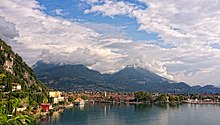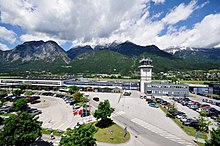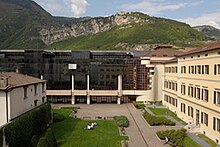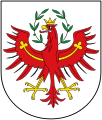Tyrol
Tyrol | |
|---|---|
|
Flag | |
| Motto: Land im Gebirge (Austrian German) Terra inter montes (Ladin) Terra fra i monti (Italian) "Country in the mountains" | |
| Capital | Tirol (1027–1418) Merano (1418–1848) Innsbruck (1848–1918) Innsbruck (1918–today) |
| Official languages | Austrian German, Italian, Ladin, Cimbrian and Mòcheno |
| Demonym(s) | Tyrolean |
| Area | |
• Total | 26,674 km2 (10,299 sq mi) |
| Population | |
• 2017 estimate | 1,813,400 |
• Density | 68/km2 (176.1/sq mi) |
| Currency | Euro (€) (EUR) |
Tyrol (
- State of
- Region of Trentino-Alto Adige: At that time still with Souramont (Cortina d'Ampezzo, Livinallongo del Col di Lana and Colle Santa Lucia) and the municipalities Valvestino, Magasa, and Pedemonte, seized in 1918 by the Kingdom of Italy, and thus since 1946 part of the Italian Republic.
With the founding of the European region
Etymology
According to
Geography
Location
Tyrol has an area of 26,673 km2. The region consists of the State of
The whole region of Tyrol is located in the
Important rivers in Tyrol are the
Mountains
As the Tyrolean region is located in the Alps, the landscape is heavily influenced by the mountains. The highest mountains in Tyrol include:
- the m a.s.l.
- the Königspitze – 3,851 m a.s.l.
- the Großglockner – 3,798 m AA
- the Monte Cevedale – 3,769 m a.s.l.
- the Wildspitze – 3,768 m AA
Across Tyrol, on the border between North and South Tyrol, runs the main chain of the Alps.[7] The main chain of the Alps geographically divides the Alps into a southern and northern half.
Biggest municipalities




Municipalities of Tyrol with over 10,000 inhabitants:
| Rank | Municipality | Inhabitants |
|---|---|---|
| 1 | Innsbruck | 132,236 |
| 2 | Trento | 117,417 |
| 3 | Bolzano/Bozen | 106,951 |
| 4 | Merano/Meran | 40,047 |
| 5 | Rovereto | 39,482 |
| 6 | Brixen/Bressanone | 21,688 |
| 7 | Pergine Valsugana | 21,363 |
| 8 | Kufstein | 18,973 |
| 9 | Laives | 17,780 |
| 10 | Arco |
17,588 |
| 11 | Riva del Garda | 17,190 |
| 12 | Bruneck/Brunico | 16,356 |
| 13 | Telfs | 15,582 |
| 14 | Eppan/Appiano |
14,900 |
| 15 | Hall in Tirol | 13,801 |
| 16 | Schwaz | 13,606 |
| 17 | Wörgl | 13,537 |
| 18 | Lana | 12,046 |
| 19 | Lienz | 11,945 |
| 20 | Imst | 10,371 |
Austria: 1 January 2017
Italy: 31 December 2016
Society
Language distribution
Tyrol can be subdivided into 5 different language groups. In addition to the majority languages such as German and Italian, languages such as
Dialects
In the Austrian state of
Heraldry
Although the details of the arms of Tyrol have changed over the centuries, one feature has remained more-or-less constant:
-
Coat of arms ofTyrol (State)
-
Coat of arms of the Province of South Tyrol
-
Coat of arms of the Province of Trentino
-
Coat of arms of theTrentino–South Tyrol
-
Coat of arms of the formerAustro-Hungarian Empire
History
Prehistory
In 1991, the mummified remains of a man who had died around 3300–3100 BC were discovered in a glacier in the Ötztal Alps, in Tyrol. Researchers have called him Ötzi (and also other names, including "The Iceman"). He lived during the Chalcolithic or Copper Age, after man had learned how to exploit copper but before man had learned how to make bronze. His body and belongings were very well-preserved, and have been subjected to detailed scientific study. They are preserved in the South Tyrol Museum of Archaeology, Bolzano, South Tyrol, Italy.
There is evidence that Tyrol was a center for copper mining in the 4th millennium BC; for example, at Brixlegg. There is also evidence of the Urnfield culture (roughly 1300–750 BC).
Evidence of the
Roman times
In 15 BC, Tyrol was conquered by Roman forces commanded by
The inhabitants adopted the Latin Language called vulgar Latin or the everyday spoken version vs. the standardized written formal form, and combined it with their own languages. The result was Romansh, which is still spoken today and is one of the official languages of Switzerland.
The Romans constructed
In late antiquity (from AD 476), Tyrol belonged to the
Middle Ages
Most of Tyrol came under the control of the

In 1027, Emperor Conrad II, in order to secure the important route through the Brenner Pass, allotted the left bank of the Adige (from Lana to Mezzocorona) to the Duchy of Bavaria. During the 12th century, the local nobility went further: they built Tyrol Castle in the modern comune of Tirol in South Tyrol, near modern Merano; and around 1140, established the County of Tyrol as a state within the Holy Roman Empire.
The Counts of Tyrol were at first
In 1253, rulership of the County passed by inheritance to the
When the Habsburgs took control of Tyrol, it had roughly its modern size. However, the
Tyrol was of great strategic importance to the Habsburgs. It controlled several important Alpine passes. It connected their landholdings in
Modern Tyrol
Tyrol's importance for the Habsburgs was underlined when the Tyrolean capital of Innsbruck became a centre of European politics and culture as
In the 19th century, Tyrol became an early pawn in the
Tyrol was reunified and returned to the Habsburgs following the downfall of Napoleon and decisions at the Congress of Vienna in 1814. Integrated into the Austrian Empire, from 1867 onwards, it was a Kronland (crown land) of Cisleithania, the western half of Austria-Hungary.
After
Politics
Tyrol–South Tyrol–Trentino Euroregion

The Tyrol–South Tyrol–Trentino Euroregion was founded in 1998. The aim is to strengthen cooperation between the separated countries.[11] In several areas, such as mobility, agriculture, education and culture will be tried to promote exchange and to raise the awareness of the cultural and historical heritage of the region of Tyrol in the minds of the population. Cross-border projects will be initiated to improve the relationship between the different language groups. To represent common ideas and values in Europe, the Euroregion has a joint office in Brussels since 1995.[12] The headquarters of the office is in Bolzano. Joint decisions are taken by organized three diet (in German: Dreier-Landtag), which have been held since 1991 mostly every two to three years with the state Diets of Trento (provincial council of Trentino), Bolzano (provincial council of South Tyrol) and Innsbruck (state council of Tyrol (State)). In 2011, the region was institutionalized and since then has its own legal entity.
Political parties
Political parties in the Italian part of Tyrol (provinces of Bolzano and Trento) include:
- Partito Democratico(PD)
- Südtiroler Volkspartei(SVP)
- Movimento Cinque Stelle(M5S)
- Lega Nord (LN)
- Greens
- South Tyrolean Freedom
- Die Freiheitlichen
- Trentino Tyrolean Autonomist Party (PATT)
The Austrian part of Tyrol shares the Austrian party system:
- Tyrol, which has dominated local politics since 1945
- Social Democratic Party of Austria (SPÖ)
- Freedom Party of Austria (FPÖ)
- The Greens – The Green Alternative
- NEOS
The multiplicity of parties is due to the fact that Tyrol lies in two different nation states and thus are politically independent of each other. Another reason for the large number of parties is the great independence of the two Provinces of
Economy
In the economic sector statistics are shown, which are based largely on numbers and data of the Tyrol–South Tyrol–Trentino Euroregion. It lacks individual communities that are outside the Euroregion. As there are no 10,000 inhabitants living in these communities, the statistics hardly distort the territory of Tyrol and the remaining 1.8 million inhabitants.
Tyrol had a total GDP of 67.6 billion euros in 2014. Divided into individual countries, the State of
Primary sector

Agriculture and forestry occupy a special position in Tyrol. The many small and medium-sized farms have shaped the landscape and culture in Tyrol for many centuries. In order to be competitive with larger farms outside Tyrol, there is a strong
Secondary sector
The first industrialization reached Tyrol late in the 19th century. Most of these were small businesses that were important only in the local area. A second wave of industrialization took place at the beginning of the 20th century. Particularly affected at that time was the city of Bolzano with the Italianization policy under Fascism in the 1920s.[22]
In 2011, approximately 10% of the workplaces in all parts of the country were active in the manufacturing sector. Thus lies Tyrol in the EU average at 10.3% (2011).[23] Important branches of industry in Tyrol are the food industry, wood processing and mechanical engineering. The industry in Tyrol consists mostly of small and medium-sized companies. The craft still plays a special role throughout the region. A large part of these craft businesses are still partially small-structured and family businesses. From an economic point of view, the energy sector is important in the secondary sector. Much of the electricity produced is generated by hydropower.
Tertiary sector

The most important sector in Tyrol is the tertiary sector. Especially tourism has a special position in this region. Due to the connection of the areas by the railway in the 19th century, many villages in Tyrol developed into popular tourism locations. The construction of the Brenner motorway in the 1960s gave the region in the 20th century a renewed upswing in the tourism branch. Today,
Also important for Tyrol is the trade. Among other things, the Exhibition of Bolzano has been a meeting point for Italian and German economy already for centuries. As a transit route country, more than 2.25 million trucks (2017) drove over the Brenner Pass.[26] This means that two times more trucks travel on the Brenner Route than in all four Alpine crossing roads in Switzerland together.[27]
Transport
Tyrol is known as a transit route. The most important route between northern and southern Europe, the Brenner route, traverses the entire region. At 1370 m above the Adriatic, the Brenner Pass is the lowest pass crossing of the main chain of the Alps. Due to the linguistic diversity and the climatic transition from temperate climate (alpine climate) to mediterranean climate, the area is regarded as a bridge between the Italian and German speaking countries.
Airports

The most important airport in Tyrol is
Road transport
Highways in Tyrol are the Brenner motorway and the Inntal motorway. The Brenner motorway runs from
Railways

The most important railway line in Tyrol is the Brenner Line via the
Further important railway lines in Tyrol are the
Local public transport
Many villages and communities are difficult to reach because of the large differences in altitude, so the region sets much on
Local public transport is usually offered with intercity buses or city buses. The city of
Culture
The Tyrolean culture has been cultivated for several centuries and passed on to future generations. The state border between South and North Tyrol is more a political border and is considered less as a cultural border. Many traditions are cultivated throughout the Tyrolean region and show little differences. In all cultural areas such as food, dress or customs there are many similarities. Nevertheless, the individual language groups, especially the minority languages, try to maintain and promote their own linguistic identity.
Tyrolean cuisine
The
The Tyrolean dishes show only slight differences throughout Tyrol. Due to the Mediterranean conditions in the southern part of Tyrol, a lot of wine is grown and is therefore also an important part of the Tyrolean dish, especially in
Tyrolean Rifles

The Tyrolean Rifles were a militia organized in case of an attack on
Customs
Many Tyrolean customs were created centuries ago and are passed on by the population for the next generations. Typical in the Alpine region are the many individual customs in the valleys. Due to the seclusion of the valleys, the locals developed their own customs. Many customs have been created by legends and narratives, others by the close connection to the church. There are also traditions that are cultivated everywhere in the Tyrolean region and do not differ from other valleys and villages. These customs give local people an identity and thus feel the community more connected.[38]
-
Dobbiaco. Typical in the alpine region.
-
Imster Schemenlaufen in Imst
-
Herz Jesu Fire in whole Tyrol
Sports
Tyrol is traditionally a winter sports country. Many athletes, such as Gustav Thöni, Benjamin Raich, Carolina Kostner, Gregor Schlierenzauer, Toni Sailer and Armin Zöggeler have already won overall World Cups and medals at World Championships and Olympic Games. Even in summer sports, several athletes from Tyrol were and still are among the best in the world. In water jumping Tania Cagnotto and Klaus Dibiasi won several medals. In cycling, Francesco Moser won the Giro d'Italia. Andreas Seppi played against the best tennis players in the world for many years. In bouldering Anna Stöhr was one of the best in the world. Many Tyrolean mountaineers such as
Football
The
In the Region of
Ice hockey
Ice hockey is a very popular sport in Tyrol. Important clubs are the
In 2005, the
and Milan.Volleyball
In volleyball,
Sports events

In Tyrol, the
Some summer sports events are also held in Tyrol. The
Universities and research institutions



Universities
- University of Innsbruck
- University of Trento
- Free University of Bozen-Bolzano
- UMIT – Private University for Health Sciences, Medical Informatics and Technology
- Medical University of Innsbruck
Colleges
- Philosophical-theological Academy Brixen
- Conservatory "Claudio Monteverdi"
- Tyrolean State Conservatory
- University of Applied Sciences Kufstein
- Health university of Applied Science Tyrol
- MCI Management Center Innsbruck
- Pedagogical University of Applied Science Tyrol
- Ecclesiastical Pedagogical University of Applied Science – Edith Stein
- State College of Health Professions "Claudiana"
Independent research institutions
- Institute for Interdisciplinary Mountain Research, a facility of Austrian Academy of Sciences
- Eurac Research
- NOI Techpark
- Foundation Bruno Kessler
- Edmund Mach Foundation
- Research-Center Laimburg
See also
References
- ^ "Tyrol". Random House Webster's Unabridged Dictionary.
- ^ The Gentleman's Magazine, Volume 75 (1794), p. 160, at Google Books
- ^ "Zeitungen aus der ganzen Welt" (in German). Retrieved 19 July 2017 – via PressReader.
- ^ Venice under the yoke of France and of Austria, p. PA1, at Google Books
- ISBN 88-7014-634-0.
- ISBN 3-7030-0279-4.
- ^ Coolidge, William Augustus Brevoort (1911). . In Chisholm, Hugh (ed.). Encyclopædia Britannica. Vol. 26 (11th ed.). Cambridge University Press. p. 1010.
- ^ Fox-Davies, A. C. (1909). A Complete Guide to Heraldry. Thomas Nelson and Sons Ltd. pp. 234–235.
- ^ "Wappen und Banner: Symbole der Autonomie". Province of South Tyrol. Retrieved 11 January 2018.
- ^ Hannes Obermair (2006). "Das Recht der tirolisch-trientinischen ‚Regio‘ zwischen Spätantike und Frühmittelalter". In Concilium Medii Aevi. 9:141–158. DOI:10.2364/1437905809107.
- ^ "Willkommen". Euroregion Tyrol-South Tyrol-Trentino. Archived from the original on 22 January 2018. Retrieved 20 January 2018.
- ^ "Europäische Integration und Euregio". Euroregion Tyrol-South Tyrol-Trentino. Archived from the original on 22 January 2018. Retrieved 20 January 2018.
- ^ "Das Autonomiestatut". Province of South Tyrol. Retrieved 20 January 2018.
- ^ "ZAHLEN ZUR EUROPAREGION". Europaregion Tirol-Südtirol-Trentino. Archived from the original on 6 February 2018. Retrieved 3 February 2018.
- ^ "Arbeitlosenquote in Südtirol bei 3,4%". suedtirolnews.it. Retrieved 3 February 2018.[permanent dead link]
- ^ "Istat, Trentino disoccupazione in calo (4,6%)". ansa.it. 7 December 2017. Retrieved 3 February 2018.
- ^ "2015 GDP per capita in 276 EU regions Four regions over double the EU average… …and still nineteen regions below half of the average". European Union. Retrieved 3 February 2018.
- ^ "Jeder 10. Apfel europäische Apfel kommt aus Südtirol". IDM Südtirol. Archived from the original on 5 February 2018. Retrieved 3 February 2018.
- ^ "Südtirol Wein". Südtirol Wein. Retrieved 3 February 2018.
- ^ "Zahlen zur Europaregion" (PDF). Europaregion Tirol-Südtirol-Trentino. Retrieved 3 February 2018.
- ^ "Pferde in Tirol:Das Glück der Erde steht auf vier Beinen". Tiroler Tageszeitung. Archived from the original on 1 March 2018. Retrieved 3 February 2018.
- ^ "ECONOMIC HISTORY" (PDF). Handelskammer Bozen. Retrieved 4 February 2018.
- ^ "Zahlen zur Europregion" (PDF). Bundesland Tirol. Retrieved 4 February 2018.
- ^ "Zahlen zur Europregion" (PDF). Bundesland Tirol. Retrieved 4 February 2018.
- ^ "Dati Provinciali sul Turismo: deludono Roma e Firenze, eccellenti Bolzano, Venezia e Rimini". scenarieconimici.it. 22 October 2013. Retrieved 4 February 2018.
- ^ "Transit: Mehr als 2,25 Millionen Lkw fuhren 2017 über den Brenner". stol.it. Retrieved 4 February 2018.
- ^ "Mehr Transit-Lkws über den Brenner als in Schweiz". tirol.orf.at. 2 December 2014. Retrieved 4 February 2018.
- ^ "Flughafen Innsbruck". flugladen.at. Retrieved 30 January 2018.
- ^ "ANAS-Immobilien gehen an das Land über – Vertrag nun unterzeichnet". Provinz Bozen. Retrieved 30 January 2018.
- ^ "Tirol und Südtirol feierten 150 Jahre Brennerbahn mit Railjet". Tiroler Tageszeitung. Archived from the original on 6 September 2017. Retrieved 30 January 2018.
- ^ Scherff, Dyrk. "Mit Tempo 250 durch die Alpen". Faz.net. Frankfurter Allgemeine. Retrieved 30 January 2018.
- ^ "MOBILITÄT UND VERKEHR". Europaregion Tirol-Südtirol-Trentino. Archived from the original on 6 February 2018. Retrieved 5 February 2018.
- ^ "Essen und trinken in Tirol". Tirol Marketing. Retrieved 21 January 2018.
- ^ "Südtirol Wein". Südtirol Wein. Retrieved 21 January 2018.
- ^ "Essen und trinken in Südtirol". IDM Südtirol. Retrieved 21 January 2018.
- ^ "Essen und trinken". trentino.com. Retrieved 21 January 2018.
- ^ "Über uns". Südtiroler Schützenbund. Retrieved 21 January 2018.
- ^ "Brauchtum". Tirol Marketing. Retrieved 21 January 2018.
- ^ "Erfolge". FC Wacker Innsbruck. Retrieved 28 January 2018.
- ^ "storia". AC Trento. Retrieved 28 January 2018.
- ^ "Geschichte". FC Südtirol. Retrieved 28 January 2018.
- ^ "Hall of fame". HC Bozen. Retrieved 28 January 2018.
- ^ "Società". Trentino Volley. Archived from the original on 5 February 2018. Retrieved 28 January 2018.
- ^ "Anche il Kazan si arrende, Trentino BetClic Campione d'Europa per la terza volta consecutiva!". Trentino Volley. Archived from the original on 23 November 2011. Retrieved 28 January 2018.
- ^ "Evers: "Die Wildcard ist eine echte Alternative"". Volleyball Bundesliga. Retrieved 28 January 2018.
- ^ "TOTA – TOUR OF THE ALPS DER EUREGIO". Europaregion Tirol-Südtirol-Trentino. Archived from the original on 6 February 2018. Retrieved 28 January 2018.
- ^ "Silvesterlauf BOclassic". südtirol.com. Retrieved 28 January 2018.
External links
- Official website
 (in German, English, and Italian)
(in German, English, and Italian)









